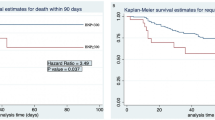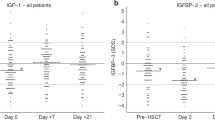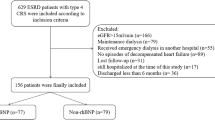Abstract
Fluid retention is characteristic of veno-occlusive disease (VOD). We hypothesized that plasma brain natriuretic peptide (BNP), a neurohormone secreted in response to volume expansion, may be associated with VOD after hematopoietic stem cell transplantation (HSCT). BNP was measured before and weekly after HSCT in 46 recipients. Sixteen patients developed VOD. BNP concentrations were similar before and on day 0 in patients with and without VOD, but were significantly higher on day 7 and later in those with VOD. Patients with VOD had significantly higher peak BNP concentrations before engraftment than those without VOD (median, 634.4 versus 80.9 pg ml−1; P=0.01). Multivariate analysis showed that VOD was independently associated with BNP elevation (odds ratio, 50.1; 95% CI: 5.2–478.4; P<0.01). Landmark analysis at day 7 showed that patients with peak BNP concentration of ⩾180 pg ml−1 had significantly worse 100-day survival than patients with peak BNP <180 pg ml−1 (54 versus 91%; P<0.01). In multivariate analysis, BNP elevation before day 7 significantly predicted 100-day survival (hazard ratio 5.3; 95% CI: 1.1–24.3; P=0.03). These findings suggest that plasma BNP may serve as a diagnostic and prognostic marker of VOD.
This is a preview of subscription content, access via your institution
Access options
Subscribe to this journal
Receive 12 print issues and online access
$259.00 per year
only $21.58 per issue
Buy this article
- Purchase on Springer Link
- Instant access to full article PDF
Prices may be subject to local taxes which are calculated during checkout



Similar content being viewed by others
References
Kumar S, DeLeve LD, Kamath PS, Tefferi A . Hepatic veno-occlusive disease (sinusoidal obstruction syndrome) after hematopoietic stem cell transplantation. Mayo Clin Proc 2003; 78: 589–598.
Wadleigh M, Ho V, Momtaz P, Richardson P . Hepatic veno-occlusive disease: pathogenesis, diagnosis and treatment. Curr Opin Hematol 2003; 10: 451–462.
Coppell JA, Brown SA, Perry DJ . Veno-occlusive disease: cytokines, genetics, and haemostasis. Blood Rev 2003; 17: 63–70.
de Lemos JA, McGuire DK, Drazner MH . B-type natriuretic peptide in cardiovascular disease. Lancet 2003; 362: 316–322.
Maisel AS, Krishnaswamy P, Nowak RM, McCord J, Hollander JE, Duc P et al. Rapid measurement of B-type natriuretic peptide in the emergency diagnosis of heart failure. N Engl J Med 2002; 347: 161–167.
Mueller C, Scholer A, Laule-Kilian K, Martina B, Schindler C, Buser P et al. Use of B-type natriuretic peptide in the evaluation and management of acute dyspnea. N Engl J Med 2004; 350: 647–654.
de Lemos JA, Morrow DA, Bentley JH, Omland T, Sabatine MS, McCabe CH et al. The prognostic value of B-type natriuretic peptide in patients with acute coronary syndromes. N Engl J Med 2001; 345: 1014–1021.
Niwa N, Watanabe E, Hamaguchi M, Kodera Y, Miyazaki H, Kodama I et al. Early and late elevation of plasma atrial and brain natriuretic peptides in patients after bone marrow transplantation. Ann Hematol 2001; 80: 460–465.
Takatsuka H, Nakajima T, Nomura K, Okikawa Y, Wakae T, Toda A et al. Prognosis value of atrial natriuretic peptide and brain natriuretic peptide for heart failure in patients undergoing allogeneic bone marrow transplantation. Hematology 2006; 11: 351–354.
Masuko M, Ito M, Kurasaki T, Yano T, Takizawa J, Toba K et al. Plasma brain natriuretic peptide during myeloablative stem cell transplantation. Intern Med 2007; 46: 551–555.
Snowden JA, Hill GR, Hunt P, Carnoutsos S, Spearing RL, Espiner E et al. Assessment of cardiotoxicity during haemopoietic stem cell transplantation with plasma brain natriuretic peptide. Bone Marrow Transplant 2000; 26: 309–313.
WHO Classification of Tumours of Haematopoietic and Lymphoid Tissues, IARC: Lyon, 2008.
Tichelli A, Bhatia S, Socie G . Cardiac and cardiovascular consequences after haematopoietic stem cell transplantation. Br J Haematol 2008; 142: 11–26.
Bone RC, Balk RA, Cerra FB, Dellinger RP, Fein AM, Knaus WA et al. Definitions for sepsis and organ failure and guidelines for the use of innovative therapies in sepsis. The ACCP/SCCM Consensus Conference Committee. American College of Chest Physicians/Society of Critical Care Medicine. Chest 1992; 101: 1644–1655.
Hingorani SR, Guthrie K, Batchelder A, Schoch G, Aboulhosn N, Manchion J et al. Acute renal failure after myeloablative hematopoietic cell transplant: incidence and risk factors. Kidney Int 2005; 67: 272–277.
Przepiorka D, Weisdorf D, Martin P, Klingemann HG, Beatty P, Hows J et al. 1994 Consensus Conference on Acute GVHD Grading. Bone Marrow Transplant 1995; 15: 825–828.
McDonald GB, Hinds MS, Fisher LD, Schoch HG, Wolford JL, Banaji M et al. Veno-occlusive disease of the liver and multiorgan failure after bone marrow transplantation: a cohort study of 355 patients. Ann Intern Med 1993; 118: 255–267.
Richardson PG, Murakami C, Jin Z, Warren D, Momtaz P, Hoppensteadt D et al. Multi-institutional use of defibrotide in 88 patients after stem cell transplantation with severe veno-occlusive disease and multisystem organ failure: response without significant toxicity in a high-risk population and factors predictive of outcome. Blood 2002; 100: 4337–4343.
Akiba T, Tachibana K, Togashi K, Hiroe M, Marumo F . Plasma human brain natriuretic peptide in chronic renal failure. Clin Nephrol 1995; 44 (Suppl 1): S61–S64.
McCullough PA, Sandberg KR . B-type natriuretic peptide and renal disease. Heart Fail Rev 2003; 8: 355–358.
Maeder M, Fehr T, Rickli H, Ammann P . Sepsis-associated myocardial dysfunction: diagnostic and prognostic impact of cardiac troponins and natriuretic peptides. Chest 2006; 129: 1349–1366.
Brueckmann M, Huhle G, Lang S, Haase KK, Bertsch T, Weiss C et al. Prognostic value of plasma N-terminal pro-brain natriuretic peptide in patients with severe sepsis. Circulation 2005; 112: 527–534.
Charpentier J, Luyt CE, Fulla Y, Vinsonneau C, Cariou A, Grabar S et al. Brain natriuretic peptide: a marker of myocardial dysfunction and prognosis during severe sepsis. Crit Care Med 2004; 32: 660–665.
McLean AS, Huang SJ, Hyams S, Poh G, Nalos M, Pandit R et al. Prognostic values of B-type natriuretic peptide in severe sepsis and septic shock. Crit Care Med 2007; 35: 1019–1026.
Bybee KA, Prasad A . Stress-related cardiomyopathy syndromes. Circulation 2008; 118: 397–409.
Richardson PG, Elias AD, Krishnan A, Wheeler C, Nath R, Hoppensteadt D et al. Treatment of severe veno-occlusive disease with defibrotide: compassionate use results in response without significant toxicity in a high-risk population. Blood 1998; 92: 737–744.
Bearman SI, Anderson GL, Mori M, Hinds MS, Shulman HM, McDonald GB . Venoocclusive disease of the liver: development of a model for predicting fatal outcome after marrow transplantation. J Clin Oncol 1993; 11: 1729–1736.
Bruneau BG, de Bold AJ . Selective changes in natriuretic peptide and early response gene expression in isolated rat atria following stimulation by stretch or endothelin-1. Cardiovasc Res 1994; 28: 1519–1525.
Bruneau BG, Piazza LA, de Bold AJ . BNP gene expression is specifically modulated by stretch and ET-1 in a new model of isolated rat atria. Am J Physiol 1997; 273 (6 Part 2): H2678–H2686.
Ma KK, Ogawa T, de Bold AJ . Selective upregulation of cardiac brain natriuretic peptide at the transcriptional and translational levels by proinflammatory cytokines and by conditioned medium derived from mixed lymphocyte reactions via p38 MAP kinase. J Mol Cell Cardiol 2004; 36: 505–513.
Henriksen JH, Gotze JP, Fuglsang S, Christensen E, Bendtsen F, Moller S . Increased circulating pro-brain natriuretic peptide (proBNP) and brain natriuretic peptide (BNP) in patients with cirrhosis: relation to cardiovascular dysfunction and severity of disease. Gut 2003; 52: 1511–1517.
Sagnella GA . Practical implications of current natriuretic peptide research. J Renin Angiotensin Aldosterone Syst 2000; 1: 304–315.
Acknowledgements
This work was not supported by any grant.
Author information
Authors and Affiliations
Corresponding author
Ethics declarations
Competing interests
The authors declare no conflict of interest.
Rights and permissions
About this article
Cite this article
Kataoka, K., Nannya, Y., Iwata, H. et al. Plasma brain natriuretic peptide is associated with hepatic veno-occlusive disease and early mortality after allogeneic hematopoietic stem cell transplantation. Bone Marrow Transplant 45, 1631–1637 (2010). https://doi.org/10.1038/bmt.2010.26
Received:
Revised:
Accepted:
Published:
Issue Date:
DOI: https://doi.org/10.1038/bmt.2010.26



